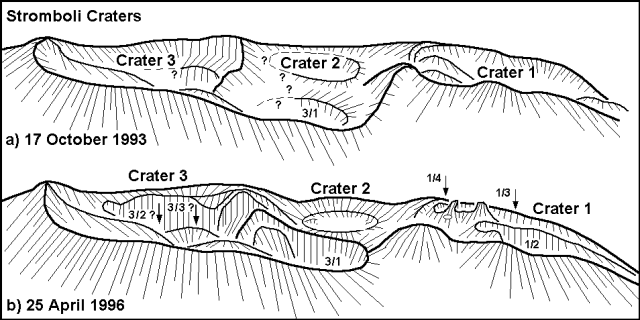Report on Stromboli (Italy) — April 1996
Bulletin of the Global Volcanism Network, vol. 21, no. 4 (April 1996)
Managing Editor: Richard Wunderman.
Stromboli (Italy) Increased seismicity and Crater 1 activity after mid-April
Please cite this report as:
Global Volcanism Program, 1996. Report on Stromboli (Italy) (Wunderman, R., ed.). Bulletin of the Global Volcanism Network, 21:4. Smithsonian Institution. https://doi.org/10.5479/si.GVP.BGVN199604-211040
Stromboli
Italy
38.789°N, 15.213°E; summit elev. 924 m
All times are local (unless otherwise noted)
Following the strong crater explosion on 16 February (BGVN 21:02), the summit seismic station of the University of Udine showed a general drop in seismic activity, as seen previously after paroxysmal phases at Stromboli (BGVN 18:01, 18:04, and 18:09). A new increase in seismic activity continued through early March with elevated average tremor intensity, while the numbers of recorded events and saturating events decreased (figure 48). After a fall in the tremor intensity on 9 and 10 March, all parameters started showing a general increasing trend that continued through the first week of April.
After a brief drop in the tremor intensity (6-8 April) and in the number of events (10-11 April), a new period of increasing seismicity began. The number of recorded events suddenly increased between 15 April (286 events) and 16 April (540 events); in the following days numbers become even greater, as the seismic station was triggered almost every minute. Stromboli volcano guide N. Zerilli confirmed that on those days Crater 1 (figure 49) erupted almost continuously, with fountaining to 40-50 m above the crater. This was the source of a rapid succession of moderate explosion-quakes that caused the high number of events recorded by the station. The number of more energetic events was also high. Strong explosive activity was continuing as of 15 May.
Field observations were made by J. and P. Alean, R. Carniel and F. Iacop during 21-28 April, although poor weather allowed only three summit visits. The most striking activity during the period was almost continuous spattering at vent 1/2 (figure 49b). Ejecta up to (and occasionally in excess of) 2 m in diameter were thrown at least 50 m high about every 30 minutes. For very short time periods (a few minutes) spattering activity at vent 1/2 would almost disappear, then increase and sometimes reach an intensity similar to the more normal, larger Strombolian eruptions. The latter occurred in Crater 1 from three distinct vents. On 21 April there were 20 eruptions at Crater 1 in 3.5 hours, some of them reaching heights of ~200 m. Cone 1/4 produced smoke rings on 22 April. On 28 April, Crater 1 produced 45 "normal" Strombolian explosions between 1300 and 1900 GMT, apart from the continuous spattering described above. Intense red glow from Crater 1 illuminated steam and clouds above it. This glow was one of the most intense ever seen by these scientists during their visits to the volcano; it could often be seen even from S. Vincenzo village.
Apart from fumarolic emissions, Crater 2 remained inactive. Crater 3 eruptions on 21 April were relatively small, albeit very noisy. Scoria did not reach heights of more than 100 m. It appeared as if the material was ejected from several individual vents or a fissure within the crater. A lot of ash was ejected, occasionally producing black mushroom-shaped clouds. Vent 3/1 had grown to an impressive size since 1994. They saw only one eruption from it, on 21 April at 1815 GMT; all the others were generated at vents 3/2 or 3/3. On 28 April activity at Crater 3 increased (55 eruptions between 1300 and 1900 GMT). By about 2100 GMT eruptions were occurring at intervals of 1-5 minutes, most of them exceeding 200 m in altitude. The ash content was clearly less than on 21 April, and brown ash clouds had become rare.
Figure 49 illustrates the change in crater morphology between October 1993 (figure 49a) and April 1996 (figure 49b). These sketches were drawn based on stereo photographs taken from the ground with a 35 mm single-lens reflex camera. The most striking morphological changes are probably in Crater 1, which saw the construction of a series of cones and their subsequent destruction, which led to the present configuration near vents 1/3 and 1/4. The zone around vent 1/2 in the foreground now appeared more open towards the Sciara del Fuoco, thus allowing better visibility of the crater from Punta Labronzo. Changes were also observed at vent 3/1, now better separated from Crater 2 on the rear and more connected to the rest of Crater 3 due to slumping of blocks between vents 3/1 and 3/3.
Geological Summary. Spectacular incandescent nighttime explosions at Stromboli have long attracted visitors to the "Lighthouse of the Mediterranean" in the NE Aeolian Islands. This volcano has lent its name to the frequent mild explosive activity that has characterized its eruptions throughout much of historical time. The small island is the emergent summit of a volcano that grew in two main eruptive cycles, the last of which formed the western portion of the island. The Neostromboli eruptive period took place between about 13,000 and 5,000 years ago. The active summit vents are located at the head of the Sciara del Fuoco, a prominent scarp that formed about 5,000 years ago due to a series of slope failures which extends to below sea level. The modern volcano has been constructed within this scarp, which funnels pyroclastic ejecta and lava flows to the NW. Essentially continuous mild Strombolian explosions, sometimes accompanied by lava flows, have been recorded for more than a millennium.
Information Contacts: Jürg Alean, Kantonsschule Zürcher Unterland, CH-8180 Bülach, Switzerland; Roberto Carniel, Dipartimento di Georisorse e Territorio, via Cotonificio 114, I-33100 Udine.



